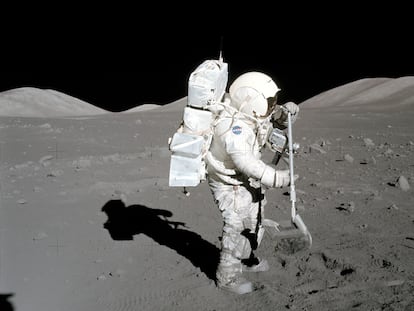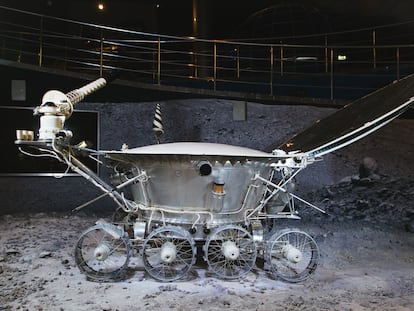India walks on the Moon
The ‘Pragyan’ rover has successfully traversed a distance of eight meters and is now preparing to carry out experiments, according to the Indian space agency
“India took a walk on the Moon.” That’s what the Indian Space Research Organisation (ISRO) announced Friday on social media. The Pragyan, a six-wheeled robotic vehicle, measuring one meter and weighing about 30 kilos, came down the ramp deployed by the Vikram lander and traveled a few meters across the lunar surface. It is the first time in history that a rover has traveled over territory near the south pole of the Moon, which has become the new promised land of space exploration. Pragyan began exploring the surface after charging its battery and conducting experiments. It is now preparing for new challenges, according to the head of the Indian space agency. Both Vikram and Pragyan are designed to run on solar-powered batteries.
“The Rover has successfully traversed a distance of about 8 meters,” the ISRO announced on social media, adding that its instruments have been turned on. “All payloads on the propulsion module, lander module, and rover are performing nominally.”
Yesterday, after 20 minutes of “terror,” the Chandrayaan-3 mission managed to slow down its dizzying orbital speed of more than 3,700 miles per hour until it settled very slowly on the surface of the Moon. Everything was done via a preprogrammed sequence, meaning it was not possible to make adjustments from Earth. It is the first spacecraft to reach the south pole of the Moon. India has also become the fourth country in the world to land on the satellite, after the United States, Soviet Russia and China. This impressive technological feat has established India as a space power capable of making history. The space chiefs of the United States and Europe celebrated the success of India’s mission, which prevailed over Russia in this new race to the Moon, following the failure of the Luna-25 probe.
... ... and here is how the Chandrayaan-3 Rover ramped down from the Lander to the Lunar surface. pic.twitter.com/nEU8s1At0W
— ISRO (@isro) August 25, 2023
The main objective of the Indian mission, which only cost about $75 million, was to carry out a soft landing on the hostile south pole of the Moon. But both the Vikram lander and the Pragyan rover are carrying instruments that can analyze the chemical composition of the terrain and perform key experiments to better determine the presence of water in this area of the Moon. The scientific work of the mission will also leave many questions unanswered, due to the limitations of the instruments, as Santosh Vadawale, leader of one of the Chandrayaan-3 experiments, explained to EL PAÍS.
“The main scientific objectives are to understand the thermal and physical properties of the lunar surface at the landing site,” he details. “We also want to study the exosphere of the Moon, which will be done by the instruments on the lander, and understand the chemical properties of the surface around the landing site, which will be done by the instruments on the rover. It should be noted that none of these instruments are designed to directly confirm the presence of water, nor is it expected that there will be water in the landing region.”
The spacecraft began operating shortly after the moon landing, when all the dust raised had settled. After checking that everything was working correctly, about four hours later, a ramp was deployed to allow Pragyan — which means “wisdom” in Sanskrit — to make its descent. The rover has autonomy to travel a few hundred meters around the landing point. It moves at a speed of one centimeter per second.
Pragyan is carrying two scientific instruments to analyze the chemical composition of the soil. One of them can shoot a powerful beam of laser light into the ground to break down the compounds and detect up to 16 different elements, including the oxygen and hydrogen that make up water.
Here is how the Lander Imager Camera captured the moon's image just prior to touchdown. pic.twitter.com/PseUAxAB6G
— ISRO (@isro) August 24, 2023
Chandrayaan-3 landed at 70 degrees south latitude. That’s the equivalent of reaching a base in Antarctica. Finding water on the Moon will be essential for establishing future bases on the satellite. It is also key to making hydrogen-based rocket fuel in order to travel to Mars and beyond, as outlined by the upcoming NASA Artemis mission to the Moon.
India has approved a space plan that aims to encourage companies to participate in lunar exploration and to exploit the Moon’s resources. The country has also just signed the U.S.-sponsored Artemis accords that establish a common framework for lunar exploration and the use of its resources. India’s rapprochement with the United States and its partners is significant, since it leaves the other great giant in this space race, China, somewhat more isolated. “We can all aspire for the Moon and beyond,” said Narendra Modi, the prime minister of India — which recently overtook China to become the most populous nation on Earth — after the successful Moon landing.
Sign up for our weekly newsletter to get more English-language news coverage from EL PAÍS USA Edition
Tu suscripción se está usando en otro dispositivo
¿Quieres añadir otro usuario a tu suscripción?
Si continúas leyendo en este dispositivo, no se podrá leer en el otro.
FlechaTu suscripción se está usando en otro dispositivo y solo puedes acceder a EL PAÍS desde un dispositivo a la vez.
Si quieres compartir tu cuenta, cambia tu suscripción a la modalidad Premium, así podrás añadir otro usuario. Cada uno accederá con su propia cuenta de email, lo que os permitirá personalizar vuestra experiencia en EL PAÍS.
¿Tienes una suscripción de empresa? Accede aquí para contratar más cuentas.
En el caso de no saber quién está usando tu cuenta, te recomendamos cambiar tu contraseña aquí.
Si decides continuar compartiendo tu cuenta, este mensaje se mostrará en tu dispositivo y en el de la otra persona que está usando tu cuenta de forma indefinida, afectando a tu experiencia de lectura. Puedes consultar aquí los términos y condiciones de la suscripción digital.
More information
Archived In
Últimas noticias
Most viewed
- Reinhard Genzel, Nobel laureate in physics: ‘One-minute videos will never give you the truth’
- Oona Chaplin: ‘I told James Cameron that I was living in a treehouse and starting a permaculture project with a friend’
- Pablo Escobar’s hippos: A serious environmental problem, 40 years on
- Why we lost the habit of sleeping in two segments and how that changed our sense of time
- Charles Dubouloz, mountaineering star, retires at 36 with a farewell tour inspired by Walter Bonatti












































